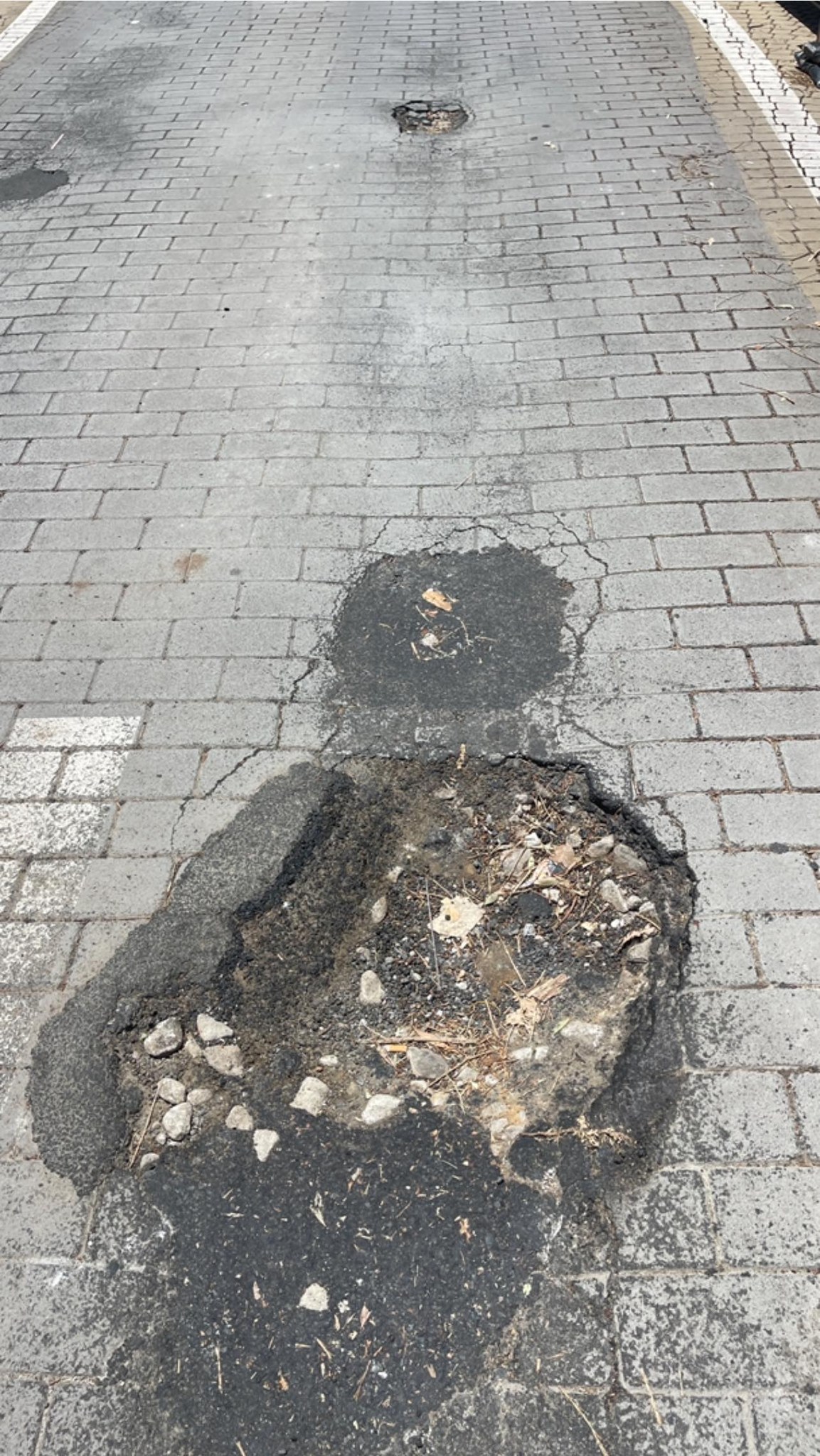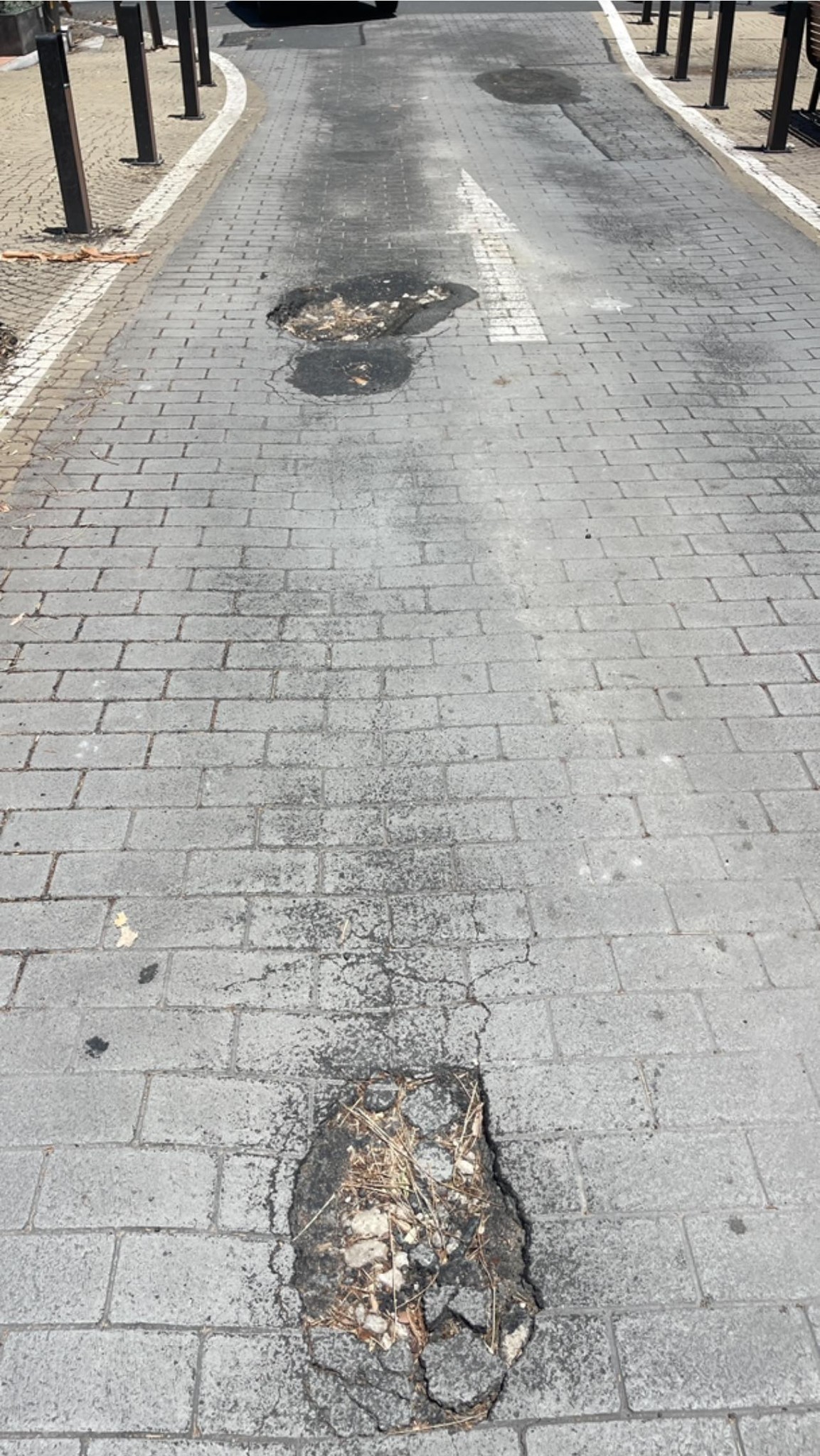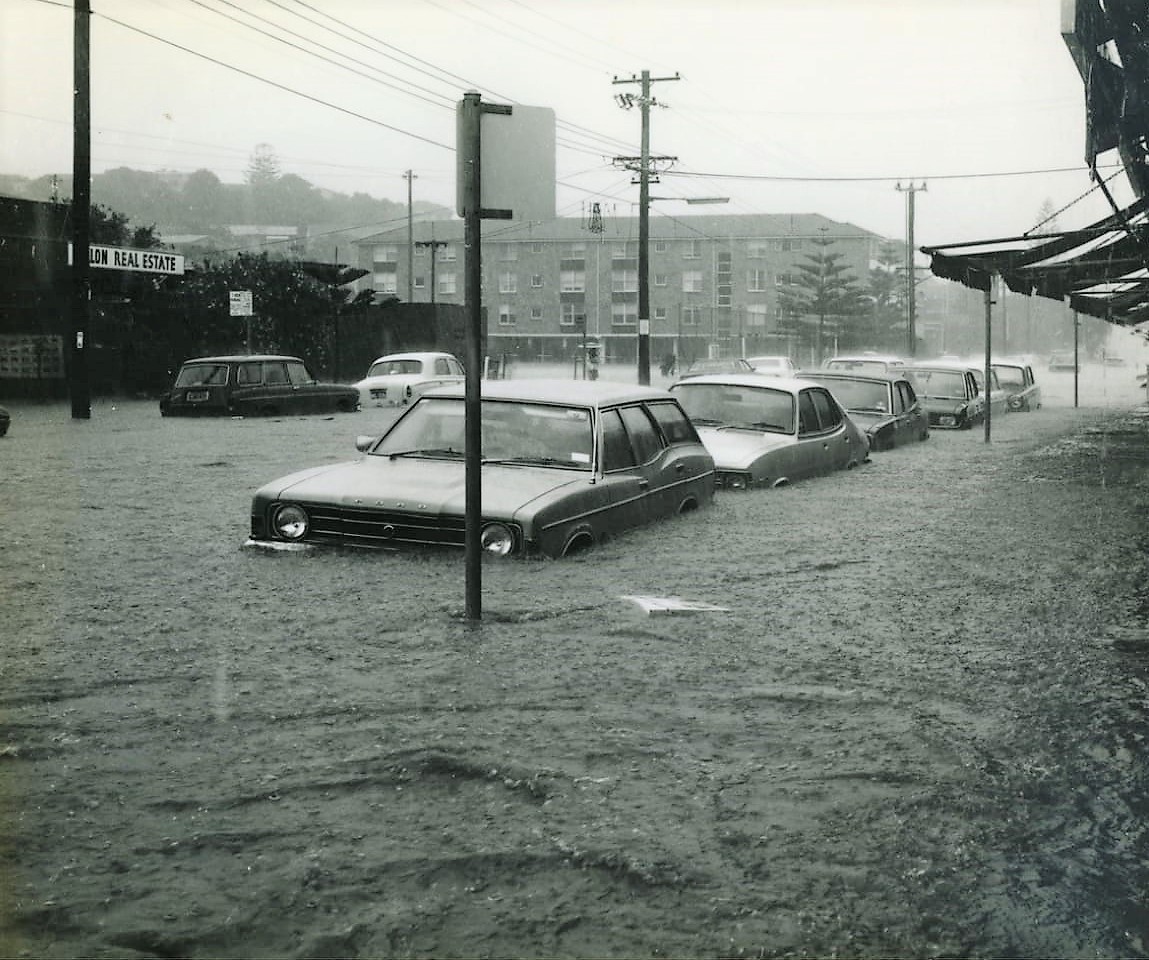Pittwater starting to look ‘patched up‘ residents state: Avalon Beach shared space cracking up – already; Newport Beach Exercise Soft-fall area has multiplying Holes
Serious concerns about the contractors and products the council is selecting have been raised by residents in regards to some recently completed works in public spaces. The sentiment is that Pittwater is beginning to look a bit ‘patched up’ soon after works have been completed.
The accruing costs of repairs, undertaken multiple times within months of works being completed, are also a factor in conversations.
In the new Avalon Beach shared space area pot holes, one quite deep, have appeared over recent months. Although filled in they begin to reappear days afterwards.
At north Avalon, where a concrete pathway was recently completed, a bus run through the just installed asphalt alongside one bus stop soon afterwards, creating a furrow that still has not been repaired.
In the Newport Beach exercise area, completed by May 2021, by November 2022 it was evident that the 'soft-fall' area, a synthetic pad installed as part of the gym equipment underlay, was deteriorating - this has since enlarged.
Avalon Beach Shared Space looking worn-out already
In January 2024 the signs of more ‘patching’ in the Avalon Shared Space became evident.
Local resident Rudi Annus, who visits the village centre each day and has engineering experience, told the news service on Friday, January 24:
‘’This lies smack bang in the middle of the shared pedestrian zone in Old Barrenjoey Rd Avalon Beach directly outside Swell Cafe, yes, the centre of the recent $500,000 Shared Spaces project designed, constructed and supervised by Northern Beaches Council.
‘’The next repair will be at least the sixth, the last around 5th December 2024 when it reached similar proportions. That repair was poorly executed and started collapsing again just 2 days later as did the many previous repairs in the same area.
This project has been an embarrassment from Day 1 and continues to be ‘not fit for purpose’ on many, many levels.
It is good luck, definitely not good management that this hasn’t resulted in a very, very serious accident which has exposed Council to a multi-million dollar insurance claim.
And they want to increase our rates ???
PS: this was AGAIN finally repaired last night (January 21 2025).’’


January 18 2024 - pics by RA and AJG
January 24 2025 pics:
Another resident stated:
‘’ For a showcase project it looks terrible. Cheap stamped asphalt, patches everywhere from pot hole and drainage repairs. Shade trees were to be included when if it became permanent - none planted. Three new mature, expensive magnolias in large pots were not watered for over a month when the shared plaza was completed. They were then removed and never replaced. Many residents enjoy this area but it looks cheap, tired and patched.’’
magnolia replacements - photo taken Friday January 24 2025
Another stated: ‘’The problem is the lack of foundation and proper thickness. Council wouldn’t let a driveway at a house be built to those standards so why have they let our money be spent on this. That concrete is like 30mm thick if that and no mesh.’’
Older residents pointed out these holes were a tripping hazard and hoped their walking stick did not get caught in them – they have advised others crossing the space to look down, not around, and watch their step.
Rudi pointed out that the drains, installed afterwards, have not been cleaned since and would be exacerbating the problem. Some are not even connected to run into stormwater drains, so the flooding will continue at the junction.
the drain installed in the southern end of the shared space area - photos taken Friday January 24 2025
He also demonstrated loose Dynabolts. These are securing seats and have also been repaired several times already – these have been sunk into asphalt which cannot hold them.
another loose bolt; these seats alongside the roadway in the shared space are a thin metal, not wood as appears, and lightweight - and could tip over easily of not bolted down - photo taken Friday January 24 2025
Rudi also pointed to the roof of the Barefoot Boulevarde building which overhangs the space and used to pour into the road's gutter now directs any rain directly into the road/seat area, without any proper 'fall' in the spaces' surface to direct it to the drain.
''Who designed this?!'' he wondered.
roofline directing rain into the space - photo taken Friday January 24 2025
This stretch of Old Barrenjoey Road, once known as ‘Priests’ Flat’ and marked on the first subdivisions of the area as a known watercourse thoroughfare, replete with mangroves that once stretched right along Careel creek to the northern end of Avalon Beach, has been flooding since before the area was turned into a holiday and then suburban place.
This photo was taken in 1974 by John Stone and shows the same location.

Photo courtesy ABHS/John Stone
In New South Wales, the warranty period for road works is typically considered to be six years for major defects and two years for minor defects; this aligns with the statutory warranty period for residential building work, meaning that contractors are liable to fix significant issues with the road for six years after completion and smaller defects for two years.
Council announced on Thursday, 15 August 2024, that it is planning to make the Avalon Streets as Shared Spaces permanent following a high level of support from the community during the 12-month trial, and will seek funding to design upgrades and improvements.
Funded by the NSW Government under the Places for People program,(Streets as Shared Spaces) work commenced in October 2022 and was completed in March 2023 when a 12-month trial began.
Background and more available in: Council states Avalon Shared Space to be Permanent: insufficient funds in Long Term Financial Plan to Deliver Avalon Place Plan - August 2024
Avalon Beach residents have also stated it would be good if Dunbar Park had a green bin installed so they could place branches blown down by storms in that when council cannot get it done - 6 to 7 days after a storm event.
Dunbar Park - photo taken Friday January 24 2025 - branches right along the path had been moved to the side of the path as children were playing on 'Avalon's Village Green'
Newport Beach Exercise Area: Soft-fall rubber deterioration continues
The deterioration at Newport Beach exercise area of installed soft-fall rubber, (safety surfaces and plastic grass) has been ongoing as well.
While some suppliers will offer a six year warranty on their products, all rely on the product being installed according to the instructions provided.
Here too there are ongoing costs. On average, wet-pour rubber surfacing is meant to last anywhere from 10 to 15 years. In some spaces the wear and tear of high use will accelerate the product’s deterioration.
However, those who supply the product state, it's important to note that this lifespan can vary based on several factors such as the quality of installation, the level of maintenance, and the choice of rubber granules or binder used.
In late March 2021 construction had commenced on the Newport Beach Exercise area and was quickly completed with concrete, a new outdoor gym, half basketball court and handball court installed by May 2021.
By November 2022 it was evident that the 'soft-fall' area, a synthetic pad installed as part of the gym equipment underlay, was deteriorating - this has since enlarged.
Toxic pollutants and plastics introduced into the beach environment is the result of this deterioration. Paradoxically, the enlarging pit was catching the 'soft' in the natural beach sand that comprises Newport Beach.
November 2022 a year and a half on from installation
January 5 2024 - more patches added in
Another associated cost is drop testing may be recommended following installation of the solid playground surfacing to confirm that the installation meets the critical fall height rating in accordance with the Australian Standard: AS 4422:2016 “Playground surfacing – Specifications, requirements and test method”. This Standard provides the general requirements for surfacing to be used in children’s playgrounds and specific requirements for areas where impact energy attenuation is necessary.
It is recommended that where wet pour rubber, soft fall tiles and synthetic grass have been installed drop tests be done every 3 years.
A drop test determines if the playground surfacing is continuing to cushion the impact of a fall from the equipment provided in the playground. The major purpose of any impact absorbing surface is to prevent serious head injuries (brain damage) to children that may fall from the equipment.
A 'wet pour' surface is a blended mix of rubber granules bound together, having been manufactured on site and laid on an existing suitable, or specially prepared base to provide a continuous surfacing free of seams or joints.
Other problems sometimes encountered include excessive wear under a moving play unit, e.g. swings, roundabouts, usually the consequence of poor quality materials or mixing, or insufficient binder.
Inspectors should be asked to look for any cracking, lifting or breaking up of the surface granules. This can be due to:
- Installation during inclement weather conditions
- Chemical problem with the binder
- Failing to ensure proper bonds between joins
- Insufficient strength in the sub-base mix
- Excessive impact absorbency in the sub-base mix
- Insufficient binder in the hard wearing course (usually noticeable by excessive sweeping off of granules)
The problems associated with people potentially inhaling what is in rubber granules have been widely reported in recent years. Concerns children may come into contact with harmful chemicals have been part of that conversation. However, as one recent study pointed out, despite there being known toxic elements in these, there is no regulatory ground to consider these unsafe as few have an established regulatory limit for their content.
Atop this, while wet pour rubber granules are often considered environmentally friendly due to their recycled tyre origin, there is growing concern about potential pollution from microplastics that can leach from the granules into the environment, particularly when they wear down and become small particles that can enter waterways and soil, raising concerns about potential impacts on aquatic life and ecosystems.
In 2023 a playground with softfall installed in Queensland was removed soon afterwards as it began deteriorating. University of Queensland research fellow Cassandra Rauert said then the materials contained a variety of potentially hazardous chemicals.
"The problem is when these small tyre pieces get into the waterways, all these chemicals are released into the water," she said.
"About two years ago, it was discovered that one of the antioxidants that are commonly used in tyres are being transformed into an acutely toxic chemical that's killing a lot of salmon over in the Unites States."
It is not recommended using these products in areas where there is a water catchment or in places that are flood-prone.
Ms Rauert said she too was concerned about the effect the rubber crumbs could have on people.
"We still have no idea about the human effects of either breathing in these small tyre particles and chemicals," she said.
"There's been a recent study which shows that these chemicals are in human urine, which means that we are being exposed, so we're probably breathing in tiny particles and then these chemicals are getting into our bodies.’’
Tangaroa Blue Foundation chief executive Heidi Tait said she was concerned that "crumbs" of the rubber material posed a risk to people's health and the environment as the material aged and disintegrated.
"We identified that rubber crumb from these soft fall playgrounds is escaping as the play area degrades and those little crumbs escape out," she said.
"When it rains, it washes into creeks and stormwater systems…’’
Ms Tait said she was particularly concerned about children inhaling the small rubber particles.
"It just seems that this product is being laid out left, right and centre in your play areas around Australia and we have not seen one park that hasn't seen this kind of degradation," she said.
"When you've got kids playing on it and inhaling, you know, the dust or the small crumb particles as they come up, or they press their hands on it and lick their hand, it's concerning."
"We just don't know what is in it or what that transfer is like."
References - Related reports
Rubber Crumb Impact Report ; ‘’ They estimate an average 1.2 million crumbs within just the first four metres surrounding the sites. One site recording a whopping 2.5 million rubber pieces. Many of these playgrounds are within metres of beaches and waterways, posing a clear risk of environmental harm.’’ From; https://tangaroablue.org/wp-content/uploads/2024/11/Rubber-Crumb-Report_2021_TBF.pdf
1. https://tangaroablue.org/the-dangers-of-playground-rubber-surfaces/ and https://www.ausmap.org/post/rubber-crumb-research-released
RUBBER CRUMB LOSS ASSESSMENT FROM PLAY AREAS IN THE GREAT BARRIER REEF CATCHMENT – November 2021 report – AUSMAPS
‘’ Environmentally persistent free radicals in crumb rubber on artificial turf infill can enter the human body via the oral cavity, weaken the salivary defense system by inhibiting the activity of salivary enzymes, and even influence the digestive and respiratory systems.’’ - 4 Dec 2023, from study titled ‘Emerging Health Risks of Crumb Rubber: Inhalation of Environmentally Persistent Free Radicals via Saliva During Artificial Turf Activities’ at: https://pubs.acs.org/doi/10.1021/acs.est.3c03278 - synthetic turf and underlay